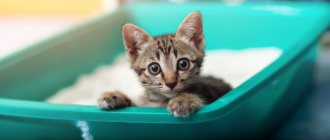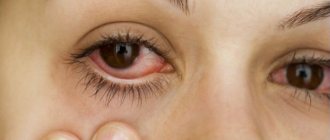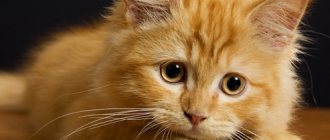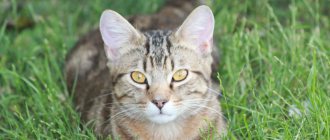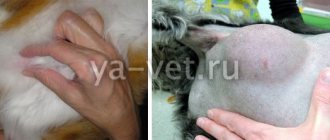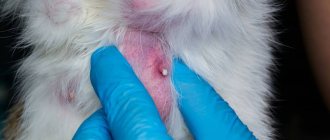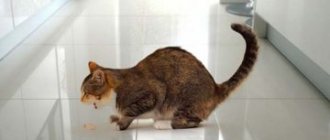The cause of the appearance of crusts may be injury - the thin sensitive skin of a cat's nose is easily injured. The cat could have scratched its nose during play, in a fight with fellow tribesmen, or in an unfortunate fall from a height. Examine the animal - if no damage is visible, the cat may have had a nosebleed and the crust has formed dry. Gently wipe your pet's face with damp cotton wool - if the crusts come off easily and the skin underneath is not changed, the cat behaves calmly, breathing is not difficult, most likely, the danger has already passed, but it is better to show the animal to a veterinarian to exclude injuries to internal organs.
If a cat's nose is scratched, there is no need to separate the crust - once it dries, it will come off on its own. Do not let the cat tear off the crust while washing, and if it interferes with his breathing, soften it with warm water, chlorhexidine or Vaseline oil, remove and lubricate the exposed skin with a wound-healing preparation, preferably with antibacterial components in the composition.
Infectious diseases
Nasal discharge that hardens in the form of crusts can be a sign of a variety of diseases, including calicivirus, viral rhinotracheitis, and reovirus infection. Pay attention to the cat’s behavior - has he become lethargic, depressed, or has his appetite deteriorated?
A common cause of crusts on the nose is calicivirus infection (calicivirus). In this case, ulcers also appear in the oral cavity.
If a cat often rubs its face with its paws and snores in its sleep, this may indicate that the animal is sick. Other signs of infection include fever, drooling, and green or purulent discharge from the eyes.
Treatment for infectious diseases is prescribed by a doctor. The sooner symptoms of a disease are detected in a cat, the sooner you need to contact a veterinarian - many diseases, especially kittens, old and weakened animals, develop very quickly, leading to death in the absence of adequate treatment.
Why does a cat go bald - reasons
01. The first reason is not at all terrible: it may be physiological reasons or seasonal changes in fur in especially fluffy individuals.
02. The second reason is adenitis. Most often it affects male cats. It appears as follows:
- crusts appear on the head and ears;
- the fur can be pulled out without causing pain or harm to the cat.
Since this disease is extremely rare, it is better to visit a veterinarian so that he can make an accurate diagnosis and prescribe treatment. While the case is pending, you can purchase a special detergent or shampoo.
03. The third reason is food allergies. Digestion in cats and cats occurs in a special way. Allergies can occur from any product.
Therefore, you should remember that you cannot share your food with your cat. It is better for her to purchase balanced food, with the necessary vitamins and supplements.
If circumstances force you to change food, it needs to be checked for the degree of digestibility, giving the pet a small amount. Read about how and what to feed your cat here.
04. The fourth reason may be injection. The fur will begin to fall off at the injection site. Gradually everything will fall into place; in this case there is no need to treat hair loss.
05. The fifth reason is seborrhea. Because of it, your furry friend suffers from peeling skin and spreads an unpleasant odor. You will have to have your blood tested at the veterinary hospital. Your veterinarian will recommend shampoo and fatty acids.
06. The sixth reason is lichen. To avoid this disease, you need to keep your cat clean. Well, if this happens, the doctor will prescribe medications.
07. The seventh reason is infestation with fleas or lice. It’s easy to get rid of them by using special hygiene products, but you should monitor your cat more carefully.
08. The eighth reason can be considered stress. When can a cat get it? Due to their personality traits, some animals may begin to go bald from stress during moving, changing housing, or participating in an exhibition. The cat is going bald on the hips, abdomen, and inner sides of the paws.
At this time, the pet needs increased attention and care. In addition, you should distract the animal from the constant desire to lick its fur, because in this case this procedure only provokes its loss.
09. The ninth reason is hormonal imbalance. Spayed or neutered animals may go bald due to hormonal imbalance. The cat behaves calmly. Treatment of baldness from this cause will be associated with taking hormonal medications, again prescribed by a doctor. The fur will be restored completely.
Skin and other diseases
The appearance of crusts on the nose often accompanies fungal and bacterial skin lesions. If you suspect a fungus or bacterial infection, you should show the cat to a doctor so that the veterinarian can examine it - make a scraping, conduct a diagnosis using an ultraviolet lamp. Other signs of skin diseases are cracks on the paw pads, ulcerations and scratches on the skin, and areas of split ends and hair falling out.
We should not forget that many skin infections of cats are also dangerous for humans, so try to exclude contacts of younger family members with a sick cat and follow the rules of hygiene.
Sometimes the appearance of crusts on the nose of cats can be caused by allergies: it can be dried discharge from allergic rhinitis or skin irritation.
The nose is the most delicate and sensitive organ. The inside is lined with a mucous membrane dotted with nerves and blood vessels; thin bones and cartilage are easily injured. A cat's nose can bleed even from a minor impact on a hard surface, for example, as a result of an unsuccessful jump. Strong odors lead to local irritation - redness, itching, swelling. A responsible owner must notice changes in time and know how to help his pet.
Curious cats poke their noses everywhere as they explore the world. Sometimes the thirst for adventure leads to bruises - an unexpectedly opened door, a springing branch, an object falling from a table. If the cat’s nose is swollen, the mucous membranes are red or bluish, and there is dried blood in the nostrils, a soft tissue bruise, fracture, hematoma, or other consequences of injury are suspected. The pet is in pain - it rubs its nose with its paw, does not allow itself to be touched, and is looking for a secluded place. If a cat has a bloody nose, dried clots block the nasal passages - the pet sniffles, sneezes, snorts. It is necessary to take the cat to the veterinarian and take an x-ray to assess the severity of the injury.
If your cat's flow doesn't stop, you should give your pet first aid. There is no need to tilt your head back or even pick up an injured animal. The cat is placed on the back of the sofa (or in another place on a hill), the nose is carefully blotted with a paper napkin, and cold is applied to the bridge of the nose. You need to act carefully, since a crack in the cartilage, a laceration, a bump on a cat’s nose and other consequences of injury are extremely painful - an indelicate touch can provoke aggression.
Preventing hair loss in cats
- It is necessary to understand that proper care of your furry pet, proper feeding, providing it with vitamins - all this will serve to prevent any diseases, including hair loss.
- It is necessary to regularly treat the animal for parasites, and also regularly conduct examinations by a veterinarian.
- By regularly examining the animal yourself, you can also determine whether there is cause for alarm by detecting the onset of baldness. With some fungal diseases, you can become infected yourself.
These measures, of course, will not be able to completely eliminate the risk of disease, but they will significantly reduce the likelihood of their occurrence.
Having settled a cute and furry friend next to you, do not forget that he needs care, to which there will always be a grateful response that will bring joy and happiness to the house.
Wounds
A scratch, bite, laceration on a cat’s nose and any other injury that breaks the skin is an entry point for billions of pathogenic microbes. To stop bleeding, the wound is blotted with a gauze swab soaked in 3% hydrogen peroxide. After a few minutes, the edges of the wound are treated with brilliant green or a healing ointment (for example,). The treatment is repeated until complete healing. If a sore on your cat’s nose does not go away within three days or an abscess forms at the site of the wound, you should consult a veterinarian.
What to do if your nose peels off?
The drug Zoomikol can be chosen by a doctor to treat fungal manifestations in an animal.
Therapy is prescribed by a veterinarian after the etiology of the disease has been established. Fungal diseases can be cured with the drugs “Fungin”, “Zoomicol”, “Sanoderm”, “Mikosept”, and “Yam” ointment. Veterinarians recommend expelling skin parasites with antiparasitic agents, such as Api-San Dekta, Amivet, Advocate, Sentry, Amitrazine. In case of an allergy, the cause should be excluded from the cat’s life. Cleaning the room is done using natural products with the addition of baking soda and laundry soap.
In case of food allergies, high-quality food should be introduced into the diet - “Bozita”, “Farmina”, “Trainer”, “Acana”, “Eukanuba”, “Pronature Holistic”. Products with seasonings, smoked foods, salty and sweet foods are prohibited. Hygiene procedures should be done 1 p. per week with clean disposable cotton swabs or pads. For the treatment of traumatic injuries, drugs such as hydrogen peroxide, Chlorhexidine, Levomekol, Furacilin, Algofin are suitable.
Infections
Heavy nasal discharge in a cat is often a symptom of infection. The fluid may be thick, clear or cloudy, flowing only after physical activity or all the time. Drainage during infections is usually bilateral, that is, the cat's nose runs from both nostrils at once. Usually, at the beginning of the disease, the liquid is watery and transparent, and as the disease develops, the cat’s nasal discharge becomes thick, foul-smelling, opaque and colored - yellowish, pinkish, swampy, etc. Heterogeneous greenish-gray discharge is pus from the cat’s nose, formed due to increased activity of pyogenic microbes. You should consult a doctor immediately, especially if symptoms include coughing and sneezing, high fever, inflammation of the mucous membranes, refusal to eat, and apathy. Many viruses are deadly, and delay is unjustifiably risky. Before visiting a veterinarian, you should not use any nasal drops for cats, as a symptomatic remedy will complicate the diagnosis. To facilitate the breathing process, the discharge is removed with a damp swab.
In addition to viruses, your cat's nasal discharge may become worse due to a bacterial or fungal infection. As a rule, illnesses of this kind indicate a decrease in immunity, which is fraught with more serious diseases. Fungus on a cat's nose may seem harmless - appetite is preserved, activity is normal. But this is a deceptive calm before the “storm”, so consultation with a veterinarian is necessary. Bacteria - cocci, etc. - also pose a serious danger due to immune suppression. If a cat’s nose is peeling, the color of the nose or the fur on its face suddenly changes, or strange crusts, dots, or spots appear on the nose, be sure to do an analysis to identify fungi/bacteria (culture).
When a sore on a cat’s nose does not heal for a long time, infection with bacteria or fungi is also suspected. In this case, the veterinarian will prescribe an ointment containing an antibiotic. Sometimes it is necessary to open the wound to remove accumulated fluid. Pus from the nose of a cat suffering from a bacterial or fungal infection of the nasopharynx indicates a worsening of the condition - the veterinarian will prescribe an intramuscular antibiotic, restorative and, possibly, immunostimulating drugs.
Allergic reactions
Clear nasal discharge in a cat can be a symptom of an allergy to anything - a new toy, the smell of powder or perfume, pollen, shampoo, etc. Signs of allergies include sneezing, inflammation of the mucous membranes, itching, lacrimation, coughing, swelling, and hair loss. If your cat's nose is peeling, it may have sniffed something irritating - vinegar, household chemicals, etc. Allergy is a chronic disease that requires systemic control for life. If you suspect this disease, you should contact a competent specialist, since an ordinary therapist cannot always reliably identify the allergen, and without excluding contact with the irritant, allergy treatment will not bring results.
Cat hair loss is a fairly common problem. The cause of hair loss and the formation of bald patches may be the presence of a disease or disorder in the body. Let's talk about why a cat's hair falls out and list the main reasons.
How to treat baldness, what to do, how to help at home?
Therapy for the disease is aimed at eliminating the causes of alopecia:
- For allergies, contact with the allergen is eliminated, the use of anti-allergy drugs, immunostimulants, and diet are effective.
- For parasitic lesions, shampoo, ointment, and spray are prescribed.
- Pyoderma and abscesses are eliminated by excision of the affected skin, antibiotics and antiseptics are used to treat wounds.
- Stressful conditions are corrected by taking sedatives.
- Malfunctions of the thyroid gland are treated with hormonal medications; if a tumor develops, surgery is prescribed.
- Bacterial folliculitis is treated with antibiotics, usually amoxicillin. The pet is washed with medicated shampoo.
- For ringworm, the hair needs to be cut, Ketoconazole, Itraconazole, Griseofulvin are taken orally.
Important! Bald spots in cats caused by hereditary causes cannot be treated.
Reasons why cats lose hair
Veterinarians identify several reasons that can affect hair loss, which becomes significant and worries the owner:
- Seasonal molt
. This process may not cause concern if the hair loss is severe, but the cat does not experience discomfort. His nose is moist, his skin is clear, normal color, and there is no discharge from his eyes. If your cat has lost hair on her neck, this may be a sign of shedding. This is a natural and normal seasonal process. In pets, it can last for almost three months. This, of course, annoys the owners who have to remove scraps of fur. But new vegetation will grow to replace the old one, and we just need to help the process and promote its growth. This can be done by enriching the cat's nutritional diet with natural foods rich in minerals and vitamins. - Diet
. Nutrition has a significant impact on all body functions, as well as on the condition of the skin and hair. An unbalanced diet can lead to a condition that causes cats to lose hair profusely, especially on the back, tail, and neck. The rest may become dull. The most unpleasant thing for a cat can be redness, peeling and itching of the places where it fell out. This most often occurs when feeding a pet sausage, sausages, and in general foods high in fat, spices and salt. We also note the fact that a large amount of whole milk in an animal’s diet can cause hair loss. - Hormonal disorders
. Veterinarians note that often owners of animals who are given drugs that suppress attraction to the opposite sex complain that their hair is falling out a lot. In this case, wounds and ulcers may appear at the site of baldness. A change in the pet’s behavior was also noticed: lethargy, loss of appetite, as well as a change in body weight towards a decrease or significant increase. - Allergic reactions
. Cats are prone to allergies, mainly food ones. Certain products can cause hair loss and a number of unpleasant symptoms: inflammation of the ears, redness of the skin in areas of bald patches and severe itching that bothers the animal; the cat is constantly itching. - Immune problems
. A disease suffered by a pet and drug treatment can cause severe hair loss. But this is only a temporary phenomenon that will gradually pass when the body gets stronger. - Facial alopecia
. This term describes hair loss in cats between the eyes and ears. The process is natural and does not relate to the disease. It can appear in a cat between the second and third years of life.
Preventing hair loss in cats
To protect your pet from the unpleasant symptoms of hair loss, owners need to follow several rules:
- Provide your cat with a balanced diet.
- Avoid factors that provoke stress.
- Vaccinate against infectious diseases on time.
- Avoid contact between a healthy animal and a sick one.
- Treat wool promptly when parasites appear.
- Carry out preventive examinations regularly.
Skin diseases
The presence of diseases can also affect the condition of the cat's fur and its loss. Let's list the ones that often occur and cause severe loss.
- Skin mites
. A skin lesion that is very unpleasant for an animal, causing discomfort with severe itching, rashes, and inflammatory phenomena that appear in areas of the skin affected by mites. You can recognize the disease by the first symptoms, which appear in the form of dull fur and bald spots on the face, ears and front legs. - Fungal diseases
(ringworm, mycosis). Having discovered the first signs of such lesions, you cannot take any measures on your own; immediately contact a veterinary clinic. We must remember that they are very dangerous for people. A sign of a fungal disease is that the hair falls out in round bald spots, which then form entire lesions. Inside them, scaly formations on the skin are noticeable. After diagnosis, the veterinarian will prescribe treatment, which must be strictly followed. - Flea dermatitis
. Flea saliva can cause an allergic reaction in cats. In addition to extensive hair loss, it can lead to severe redness and itching of the skin. With this disease, most often cats may lose hair on their back. - Allergic dermatitis
. Cats can react to irritants such as household chemicals, pollen, dust, etc. All these substances can cause quite severe allergies, which, in addition to hair loss, causes discomfort to the pet in the form of itching, redness of the skin, and the cat develops sores in areas where it is scratched. - Psychological reaction to external factors
. The sensitivity of cats to external stimuli is not new. Any phenomenon that causes stress in an animal can make the cat not only timid and even aggressive, but also encourage him to pull out his fur with his teeth in those areas where he can reach. This includes the stomach, the back, and the paws. At the same time, bleeding wounds and ulcers appear on bald skin, which can become a gateway for various infections. - Seborrhea
. This skin disease is characterized by particularly severe hair loss on any part of the body. The skin becomes inflamed, oily, and foul-smelling.
Only a competent veterinarian can determine the exact reason why a cat’s hair is falling out, because the same symptoms can be a manifestation of various diseases. To make a diagnosis, you will need to undergo a series of examinations and tests. Based on the diagnosis, the doctor will prescribe treatment that will help restore the pet’s skin and coat.
Why does a cat go bald: reasons
Baldness (alopecia) leads to the appearance of bare patches of skin on your pet's body.
If there is too much hair, bald spots appear, the animal behaves restlessly
The main reasons for the development of pathology:
- allergic reaction;
- damage by fleas, lice;
- the presence of a scabies parasite;
- otodectosis (ear mites);
- fungal or lichen infections (dermatomycosis, dermatophytosis);
- pyoderma;
- purulent formations on the skin;
- oily seborrhea;
- deficiency or excess of thyroid hormones;
- increased work of the adrenal glands;
- diabetes;
- genetic predisposition;
- stress;
- lack of vitamins;
- chronic diseases of internal organs.
Important! A common cause of alopecia is food allergies. It is not recommended to give pets food from the human table. Veterinarians advise buying specialized food that contains the necessary vitamins and minerals.
Fighting baldness in cats
Cat owners, having noticed changes in the animal’s hair, begin to panic and look for an answer to the question of what to do if the cat’s hair falls out. Different causes of hair loss require different treatment approaches.
The longest and most difficult treatment is when hair falls out from skin mites and fungal diseases, which require the use of toxic drugs strictly according to the regimen prescribed by the doctor. At the same time, a thorough disinfection of the room will be required, including treatment of all carpeting and furniture, as well as disinfection or replacement of the cat’s bedding.
The result of an unbalanced diet, accompanied by signs of partial baldness, for example, when a cat has flaking hair on its hind legs, is treated mainly with diet. Pets on dry food should receive enriched vitamin complexes, and those on a natural diet should receive low-fat foods with the addition of B vitamins. To relieve itching, antihistamines can be given in small doses no more than twice a day.
Wounds and crusts on a cat’s nose are a consequence of dermatitis, an allergic reaction or an infectious disease. At home, it is impossible to make a diagnosis on your own, since this requires a culture of the flora from the nose and an analysis of scrapings.
The crusts on your cat's nose may be brownish or black. This symptom is characteristic of a fungal infection, an inflammatory process in the nasopharynx, or an allergic reaction. The most harmless cause of crust formation is considered to be household injuries.
The fact is that a healthy cat’s nose is slightly wrinkled. This prevents the normal restoration of damaged skin, so wounds can take a long time to heal. If the owner is absolutely sure of the nature of the crusts, it is necessary to help the pet’s body recover as quickly as possible. To do this, it is recommended to treat your nose with an antiseptic several times a day. Preventing re-infection of the wound significantly accelerates regeneration and the crusts begin to disappear a few days after the start of treatment.
A dark crust on the nose, which is accompanied by discomfort and is a consequence of skin damage, should not be a cause for concern. In this case, no treatment is required; the crust will fall off on its own when the tissues are completely restored.
Treatment with an antiseptic is only necessary if weeping erosions or crusts appear at the site of the wound, blocking the respiratory tract.
Baldness in cats, how to deal with shedding: advice from a veterinarian
Seasonal shedding is normal. This period is especially noticeable for owners of long-haired pets. Molting can last from 2 weeks to 3 months. Veterinarians advise washing and combing animals more often during this time.
Effective shampoos against hair loss:
- "Phytoelite" from "Veda";
- SynergyLabs Shed-X Cat;
- Perfect Coat 8 in 1.
It is useful to take vitamin complexes, preferably in liquid form.
Bald spots in cats caused by hereditary causes cannot be treated.
To remove hair from the stomach, it is recommended to give special medications:
- Pet Naturals of Vermont;
- Actipet;
- Vaseline oil, etc.
Ordinary grass can help get rid of lumps; in the summer, it is enough for the animal to go for a walk; in winter, the seeds can be purchased at pet stores and planted yourself.
If shedding is accompanied by specific signs, it is necessary to show the cat to a doctor.
Infectious diseases
If a cat has black crusts on his nose that do not heal for a long time, the cause should be sought in infectious diseases. Associated symptoms of infectious diseases:
- Nasal discharge.
- Otitis.
- Lethargy.
- Increased sleepiness.
In this case, the animal may refuse to eat and be lethargic. Particularly severe forms of infectious diseases are accompanied by vomiting and dehydration.
Cat infections are very dangerous, especially if the animal does not have all the necessary vaccinations. Black crusts on the nose are one of the most harmless symptoms; in severe cases, infectious diseases can lead to the death of the pet. You cannot try to cure the cat yourself; you should take the animal to a veterinary clinic. This may require long-term hospital treatment.
Disease Prevention
Prevention of cat diseases includes:
- Rational, balanced nutrition. Lack of vitamins, microelements and nutrients necessary for the animal weakens the body.
- If it is not planned for cats to continue breeding, but to be kept only as a pet, sterilization (castration) is recommended. Sexual arousal negatively affects the health of animals, leading to congestion in the genitourinary system, fights and injuries.
- White individuals should not be allowed outside all day in the summer.
- Animals that participate in exhibitions or are kept free-range are recommended to be vaccinated. You must first make sure that your pet is healthy and not a virus carrier.
A healthy lifestyle includes minimizing stress. Affectionate, trusting communication with an animal not only maintains an emotional connection, but also strengthens the immune system.
Dermatological diseases
Crusts on a cat’s nose can be the result of skin pathologies and dermatitis. These diseases are caused by fungi and bacteria. To accurately determine the cause of the formation of crusts, it is necessary to undergo a series of tests, including a nasal microflora smear and skin scraping from the affected area. The doctor will also illuminate the animal with a special lamp, which allows you to quickly determine the presence of fungal infections.
Treatment depends on the type of disease. For fungal infections of the epidermis, antimycotic drugs are used. Treatment is carried out using ointments and solutions for treating the nose. In case of a bacterial infection, the crusts should be treated with antibacterial drugs, for example, Levomekol ointment.
For dermatological diseases, antiseptic treatment of the affected area is mandatory. This is necessary to prevent secondary infection. For this purpose, a solution of chlorhexidine or miramistin is used.
Wounds and allergies
Sores and crusts on a cat's nose and around the lips may be the result of an allergic reaction. Typically, such symptoms appear in response to food allergens, but damage to the skin of the nose can be caused by contact with household chemicals.
For treatment, special antihistamine drops are used. You can buy them at a veterinary pharmacy. If the allergic reaction is moderate, it is enough to eliminate the irritant for the symptoms to subside. No specific treatment is required; it is enough to avoid contact with the allergen in the future and treat the crusts with an antiseptic to prevent infection.
Calcivirosis
If a black crust suddenly appears on your cat’s nose, you should take a close look at the animal’s behavior. One of the dangerous cat diseases is calcivirosis. Animals are usually vaccinated against this disease, but street cats that accidentally enter the house may not be vaccinated. Symptoms of calcivirosis:
- wounds and crusts on the mucous membranes of the mouth, ears and nose;
- conjunctivitis and tearing eyes;
- damage to the paw joints;
- increased body temperature;
- swollen lymph nodes;
- labored breathing.
To treat calcivirosis, you should consult your doctor about the use of medications. There is no universal treatment regimen for this disease; therapy is selected depending on the symptoms and age of the pet.
Crusts on the nose should be lubricated with chlorhexidine or Lugol's solution twice a day. To make breathing easier, the nasal passages must be treated with special drops.

